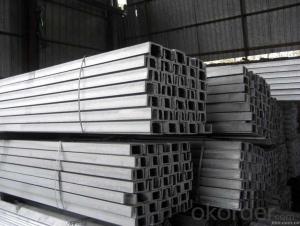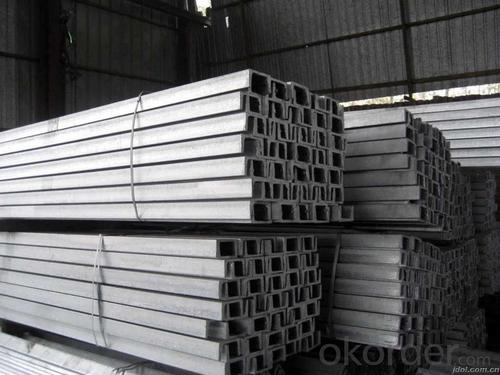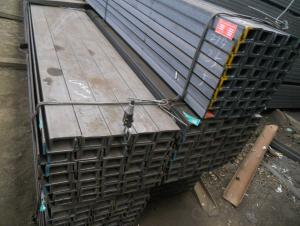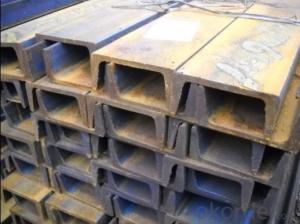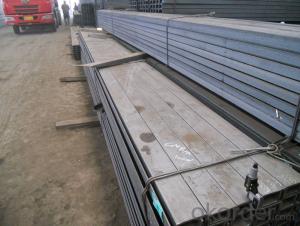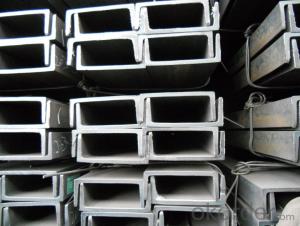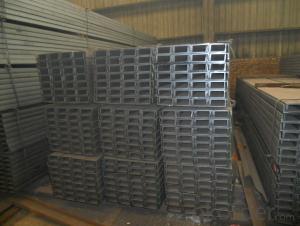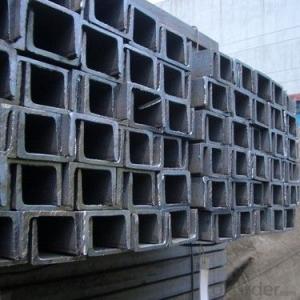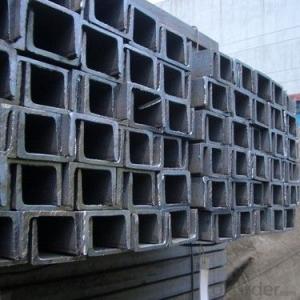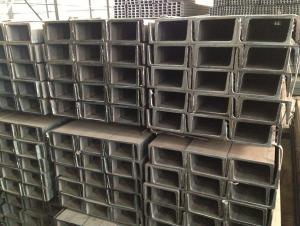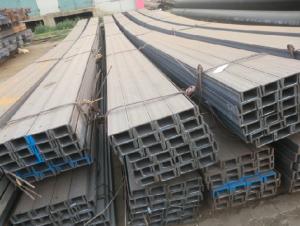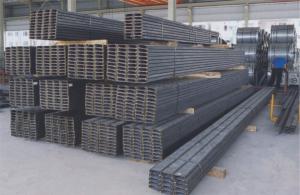JIS SS400 Steel Channel with High Quality 50mm
- Loading Port:
- Tianjin
- Payment Terms:
- TT OR LC
- Min Order Qty:
- 25 m.t
- Supply Capability:
- 10000 m.t/month
OKorder Service Pledge
OKorder Financial Service
You Might Also Like
JIS SS400 Steel Channel with High Quality 50mm
Product Description:
Standard: JIS
Material: SS400
Length: 6m, 12m
Size:
Size (mm) | Mass (Kg/m) |
50*25*3.0 | 2.37 |
Package & Delivery of JIS SS400 Steel Channel with High Quality 50mm:
1.The hot rolled channel steel will be packed in bundle with steel wire at each end of every bundle and color marking in order to help the customer to recognize his goods more easily at sight.
2. And the hot rolled channel steel could be loaded into 20ft or 40ft container, or by bulk cargo.If the weight of each bundle reaches more than 3.5 mt, the loading by break bulk cargo should be choosed.When the weight of each bundle reaches less than 3mt, the loading by container should be choosed.
3.As for the transportaion from mill to loading port, the truck will be usually used. And the maximum quantity for each truck is 40mt.
4.All in all, we could do in accordance with customer's request.
Production Flow of JIS SS400 Steel Channel with High Quality 50mm:
1.The steel billet shall be heated in the high temperature furnace.
2. The heated steel billet shall be rolled five to nine times with the aim of shaping the general figure of steel u channel.
3. The rolled steel channel should be put onto the cooling bed to make the temperature low.
4. The JIS Channel should be straighted on the straightener.
5. The straighted steel u channel will be cut into meters by saw, as per customer's requirements.
6. At the last part of production, the channel steel must be tested in order to confirm that the finished products are completely free from crack, pore, slag, scab or fold on the surface.
FAQ:
Q1: Why buy Materials & Equipment from OKorder.com?
A1: All products offered byOKorder.com are carefully selected from China's most reliable manufacturing enterprises. Through its ISO certifications, OKorder.com adheres to the highest standards and a commitment to supply chain safety and customer satisfaction.
Q2: How do we guarantee the quality of our products?
A2: We have established an advanced quality management system which conducts strict quality tests at every step, from raw materials to the final product. At the same time, we provide extensive follow-up service assurances as required.
Q3: How soon can we receive the product after purchase?
A3: Within three days of placing an order, we will arrange production. The shipping date is dependent upon the quatity, how many sizes you want and the plan of production, but is typically 1 month to 2 month days from the beginning of production.
Images of JIS SS400 Steel Channel with High Quality 50mm:
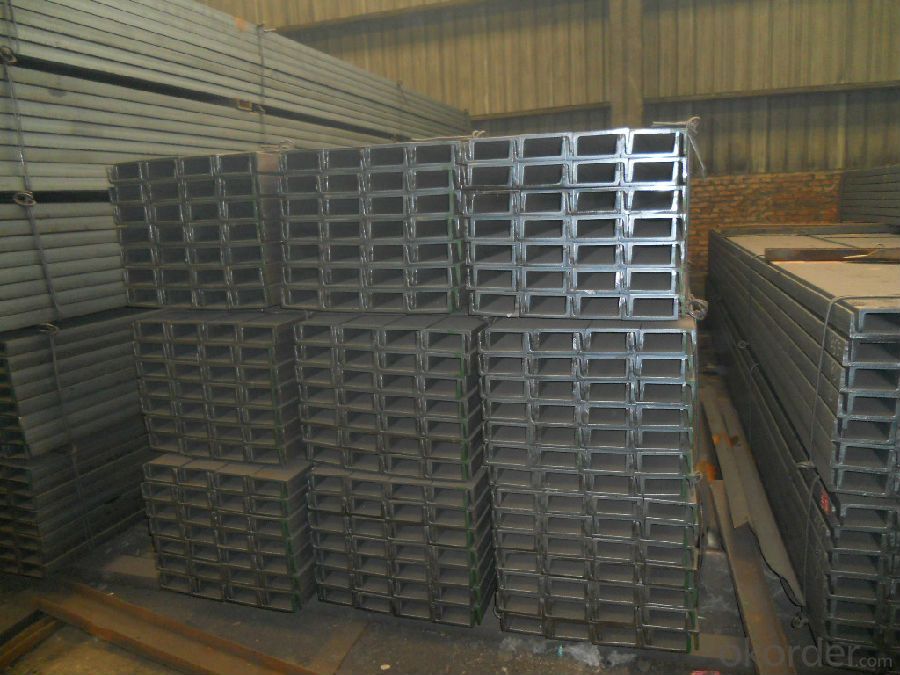
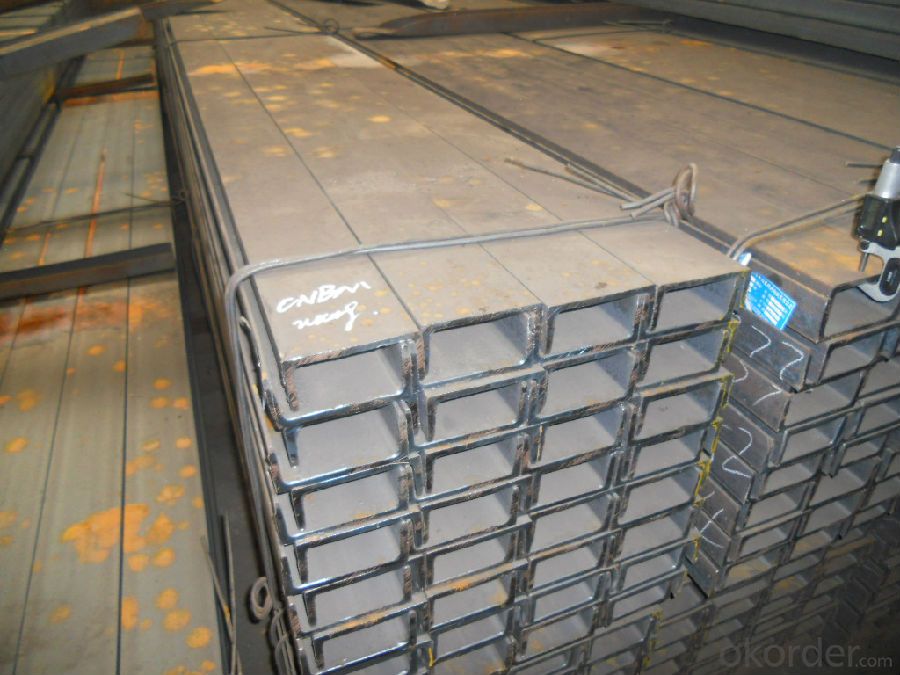
*If you would like to get our price, please inform us the size, standard/material and quantity. Thank you very much for your attention.
- Q: How do steel channels compare to timber or concrete channels?
- Steel channels have numerous advantages over timber or concrete channels. Firstly, they possess greater strength and durability in comparison to timber channels. With a higher load-bearing capacity, steel channels can withstand heavy loads without warping or bending. This attribute makes them exceptionally well-suited for applications where strength and durability are essential, such as construction projects or industrial settings. Secondly, steel channels exhibit more resistance to environmental factors such as moisture, rot, and pests, which can significantly impact timber channels. Unlike timber channels, steel channels do not require regular maintenance, potentially eliminating the need for treatments or replacements over time. Additionally, steel channels offer enhanced design flexibility when compared to timber or concrete channels. They can be easily fabricated and customized to fit specific dimensions and requirements, making them suitable for a wide range of construction and engineering projects. Furthermore, steel channels possess a longer lifespan than timber or concrete channels. They are not prone to decay or degradation, ensuring that they will endure for many years without the need for replacement. This longevity can result in cost savings in the long run, as there is no necessity for frequent repairs or replacements. In conclusion, steel channels deliver superior strength, durability, resistance to environmental factors, and design flexibility in comparison to timber or concrete channels. They are a reliable and efficient choice for various construction and engineering applications.
- Q: Can steel channels be used in industrial buildings?
- Yes, steel channels can be used in industrial buildings. Steel channels, also known as C-channels or U-channels, are structural members made of steel that have a C or U shape. They are commonly used in construction and industrial applications due to their strength and versatility. Steel channels can be used in industrial buildings for various purposes. They are often used as support beams or columns to provide structural stability and load-bearing capacity. Steel channels can effectively distribute the weight of heavy machinery, equipment, and materials, making them suitable for industrial applications where there is a need for strong and durable structural components. Additionally, steel channels can be used for framing walls, roofs, and floors in industrial buildings. They can be easily connected and welded together to create rigid and stable frames. Steel channels also offer flexibility in design, as they can be cut and shaped to fit specific requirements and specifications. Furthermore, steel channels have excellent resistance to corrosion, making them suitable for industrial environments that may expose the building to moisture, chemicals, or other harsh conditions. They have a long lifespan and require minimal maintenance, which is advantageous for industrial buildings that need to withstand heavy usage and demanding operations. Overall, steel channels are a popular choice in industrial buildings due to their strength, versatility, and resistance to corrosion. They provide structural stability, support heavy loads, and offer design flexibility. Whether it is for support beams, framing, or other applications, steel channels can effectively meet the requirements of industrial buildings.
- Q: What are the different types of steel channel connections for door frames?
- Door frames commonly utilize various types of steel channel connections, including welded connections, bolted connections, riveted connections, corner brackets, and adjustable connections. The most prevalent method for steel channel door frames is welded connections. This involves welding the steel channels together at the corners to create a robust and secure frame. Alternatively, bolted connections are frequently employed. This approach entails drilling holes in the channels and inserting bolts to fasten the frame. This type of connection allows for convenient disassembly and reassembly, if necessary. Riveted connections are also utilized in steel channel door frames. This method involves drilling holes in the channels and inserting rivets to hold them together. Riveted connections offer a resilient and long-lasting connection. In some instances, corner brackets may be used to connect the steel channels. Made of steel, these brackets are affixed to the corners of the channels using screws or bolts. Corner brackets provide additional stability and strength to the door frame. Certain steel channel door frames may feature adjustable connections. These connections facilitate easy adjustment of the frame during installation to ensure it is level and plumb. Typically, screws or bolts are used to hold the channels in place, allowing for flexibility in positioning. Ultimately, the choice of steel channel connection for a door frame depends on various factors, including project requirements, desired strength and stability, and ease of installation and maintenance.
- Q: What are the considerations for steel channel connections to timber structures?
- When considering steel channel connections to timber structures, there are several important factors to keep in mind. Firstly, it is crucial to ensure that the connection is structurally sound and able to withstand the required loads and forces. This involves carefully calculating and designing the connection to ensure that it can bear the expected load without failure. Secondly, compatibility between steel and timber should be considered. Different materials have different expansion and contraction rates, so provisions must be made to accommodate these movements and prevent any potential issues, such as splitting or excessive stress on the connection. Additionally, the connection should be designed to prevent corrosion, as steel is susceptible to rusting. Proper measures, such as using protective coatings, galvanizing, or isolating materials, should be implemented to minimize the risk of corrosion and ensure the long-term durability of the connection. Lastly, it is important to follow applicable building codes and regulations when designing and constructing steel channel connections to timber structures. These codes provide guidelines and standards that must be adhered to in order to ensure the safety and structural integrity of the connection.
- Q: What are the factors to consider when determining the appropriate height of a steel channel?
- When determining the appropriate height of a steel channel, several factors need to be considered. These factors include the load-bearing capacity required, the span or distance between supports, the type and weight of the load being supported, the material properties of the steel channel, and the desired deflection or bending of the channel under load. Firstly, it is crucial to assess the load-bearing capacity required for the steel channel. This involves considering the maximum weight the channel needs to support without buckling or failing. The load-bearing capacity depends on the application and the anticipated loads that will be applied to the channel. The span or distance between supports is another critical factor. Longer spans generally require taller steel channels to provide adequate support and minimize deflection. Shorter spans, on the other hand, may allow for smaller and less rigid channels. The type and weight of the load being supported are also important considerations. Different loads exert different forces on the channel, such as point loads or uniformly distributed loads. Heavier loads will require taller and stronger steel channels to ensure structural integrity. The material properties of the steel channel play a role in determining the appropriate height. Different steel alloys have different strength and stiffness properties. The choice of alloy will depend on the load requirements and the structural design. Lastly, the desired deflection or bending of the channel under load needs to be considered. Deflection refers to the amount of flex or bending that the channel experiences when loaded. In some applications, minimal deflection is desired, while in others, some deflection may be acceptable. In conclusion, when determining the appropriate height of a steel channel, it is vital to consider factors such as load-bearing capacity, span, type and weight of the load, material properties, and desired deflection. A thorough analysis of these factors will help ensure the steel channel is appropriately sized and capable of meeting the intended structural requirements.
- Q: Can steel channels be used for supporting exterior cladding systems?
- Yes, steel channels can be used for supporting exterior cladding systems. Steel channels are strong and durable, making them suitable for providing structural support to the cladding. They can be used to create a framework that holds the cladding in place, ensuring it is securely attached to the building's exterior. Steel channels also offer versatility in design and can be customized to meet specific project requirements. Additionally, steel is resistant to weathering and corrosion, making it a reliable choice for exterior applications where the cladding needs to withstand various environmental conditions. Overall, steel channels are a popular choice for supporting exterior cladding systems due to their strength, durability, and versatility.
- Q: 16A channel steel size requirements are national standards Oh!
- Height 160, width 63, wall thickness 6.5, theoretical weight 17.24KG/M
- Q: Can steel channels be used for framing?
- Yes, steel channels can be used for framing. Steel channels provide structural strength and stability, making them suitable for framing applications in various construction projects.
- Q: What do you mean by "A" in the channel type?
- The same waist height, according to its thickness is divided into a, B, B, C or a.
- Q: Can steel channels be used for supporting mezzanine floors?
- Indeed, mezzanine floors can be supported by steel channels. In the realm of construction, steel channels are frequently employed due to their robustness and resilience. Their exceptional capacity for bearing substantial loads and withstanding deformation or torsion makes them an ideal choice for providing optimal support to mezzanine floors. Typically, steel channels are combined with other structural elements like beams and columns to establish a strong framework for mezzanine floors. By utilizing steel channels, the structural integrity of mezzanine floors remains intact, allowing them to safely accommodate additional weight, be it storage racks, equipment, or personnel.
Send your message to us
JIS SS400 Steel Channel with High Quality 50mm
- Loading Port:
- Tianjin
- Payment Terms:
- TT OR LC
- Min Order Qty:
- 25 m.t
- Supply Capability:
- 10000 m.t/month
OKorder Service Pledge
OKorder Financial Service
Similar products
Hot products
Hot Searches
Related keywords
